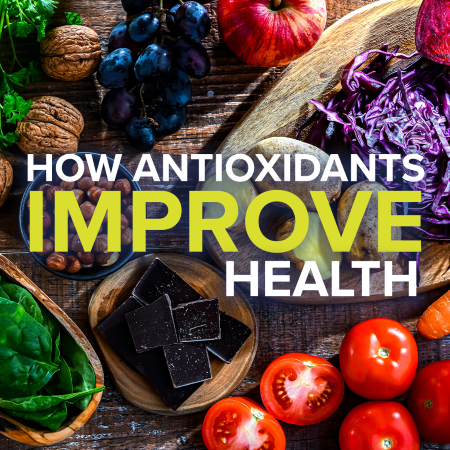Antioxidants and polyphenols seem to go hand in hand. We often use them interchangeably as if they’re the same word, but they are actually different. At Atrantil, we usually focus on polyphenols, but today we want to answer the question: What are antioxidants, and how do they improve our health?
This article is to help you understand just that — what antioxidants actually are and what they do for your body.
Antioxidants vs Free Radicals
Our bodies were created to maintain homeostasis — in other words, they were created to keep balance within themselves.
Antioxidants are created by our bodies naturally, but can also be found in the foods we eat.
Antioxidants are exactly what their names suggest: They oppose reactive oxygen species (ROS) in our bodies. ROS are a form of free radicals that result from different natural processes within our bodies. Metabolic processes in our bodies that happen when eating, digesting, or exercising increase ROS.
Free radicals can also come from the external world, from things like
- Cigarette smoke
- Environmental pollutants
- Chemicals
- Cosmetics
- Pesticides
Free radicals are very unstable and need other products in our bodies to keep them in line. They’re sort of like highly energetic kids that need an outlet for their energy before they can focus.
Once you give these free radicals what they need to balance themselves out (antioxidants), they aren’t all bad.
However, when the ROS accumulate at high levels and aren’t being balanced out, they can cause harm. Excessive amounts of ROS lead to oxidative stress, and this results in most diseases.
Cancer, cardiovascular diseases, strokes, and many other diseases have been linked to oxidative stress.
Antioxidants scavenge the free radicals and give them an electron to balance them out, which is how antioxidants can help avoid diseases.
Different Levels of Antioxidant Action
Antioxidants work in different stages depending on how high the levels of free radicals are.
Preventative Antioxidants
Preventative antioxidants prevent the formation of free radicals. They go throughout the body donating their electrons so that free radicals can’t form to begin with.
This is the state that you want your body to be in. This is homeostasis for your prooxidant/antioxidant processes.
Scavenging Antioxidants
Once the chemical reactions start happening, the scavenger antioxidants head out and stop the reactions before they can cause much damage.
These are broken down into water-soluble and fat-soluble antioxidants. This is where you see a difference between the ones that your body naturally creates and those that you take in as vitamins and minerals.
Vitamins C and E are some of the best scavenger antioxidants.
Antioxidants for Repair
Once the damage has already happened within your proteins, these antioxidants go out and fix the damage. They’re like a post-storm cleanup crew that goes out after hurricanes and tornadoes.
They go out and see the damage that has been done, degrade the oxygen species there, and repair or get rid of harmed proteins. Special antioxidants can help repair damaged DNA, as well.
Adaptation allows our bodies to recognize what antioxidants are needed and signals for more of them to be created. Once our endogenous antioxidants are called in, the adaptation system sends them to the appropriate areas they were created for in the first place.
Getting Enough Antioxidants
Our bodies create some of the antioxidants that we need, but not all of them. Our diets supplement the remaining antioxidants that we need but don’t naturally produce.
Western diets don’t incorporate enough foods that offer antioxidants to combat free radicals, which is why such an increase in obesity and related diseases has been seen.
Comparing the Mediterranean diet and the Western diet, you’ll see a drastic difference in disease levels. These differences are based on polyphenol and, therefore, antioxidant intake levels.
Some foods you’ll want to incorporate into your diet to get extra antioxidants include:
- Green tea
- Cocoa
- Wine
- Olive Oil
- Curcumin
- Turmeric
- Cranberry and pomegranate juices
- Grapes
- Citrus fruits
Supplementation has become a common form of getting enough antioxidants in the Western world. This has become a concern, though, causing what doctors are referring to as the “antioxidant paradox.”
Synthetic phenolic antioxidants are very unstable at high temperatures. The two main ones used in the food and cosmetics industries are:
- Butylated hydroxytoluene (BHT)
- Butylated hydroxyanisole (BHA)
These fake antioxidants can be carcinogenic and lead to other diseases.
In a 2009 analysis, it was found that adults in the United States got the following percentages of antioxidants from supplements:
- Vitamin C — 54%
- Vitamin E — 64%
- Alpha- and Beta-carotene — 14%
- Selenium — 11%
While consuming too many antioxidants in food hasn’t been seen, it’s pretty easy to get too much from supplements.
Too high levels of certain antioxidants can lead to the following diseases:
- Beta-carotene — lung cancer
- Vitamin E — hemorrhagic stroke and prostate cancer
Supplements can also have adverse reactions with other medications you are taking. Vitamin E can enhance blood-thinning medications, increasing the chances of excessive blood loss or bruising.
Making sure you have a high-quality supplement that is from real ingredients is the key to ensuring the safe supplementation of your antioxidants.
Atrantil is a great example of a safe supplement since it has the seal of approval from the NSF. This certification means that each batch is proven to be of the highest quality available. No fake additives or contaminations are allowed for products with the NSF stamp.
You don’t have to worry about having a product that can potentially hurt you when you choose Atrantil.
Of course, you should always talk with your doctor before adding any supplements to your daily routine. Atrantil is always a safe bet for getting your extra dose of polyphenols and antioxidants.
What is your favorite way to get extra antioxidants into your diet? Let us know in the comments below!